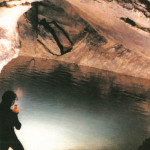This valley is located in the vicinity of Hadshit Village, in the Qadisha Valley. The field work and researches carried out by the GERSL shed light on a great number of built heritage (water mills, stone bridges, rupestrian monasteries & painted chapels) and caves most of which goes back to the 12th and/or 13th century A.D. The results were published in the GERSL journal Liban Souterrain 1, 2 and 3. It is worth noting that one sinkhole was used as a burial site around 1400 B.C.; the date is corroborated by some typical pottery of that period.
Below is a bried on some of the most important sites:
- Deir as Salib: a rupestrian monastery built partially in stone and partially in mud bricks; the cave house a double apse chapel covered with mural paintings from the 12th century.
- Houet Hadshit: a shallow sinkhole housing a burial site dated back to the Late bronze age period around 1400 B.C. the site was partially vandalized, but one can still observe some structural stones, wooden beams and painted pottery.
- Mart Shmuni: a rupestrian chapel that dates back to the 13th century A.D., earlier covered with Frescoes, destroyed today. However, and thanks to a photographic documentation prior to the destruction, the GERSL, in collaboration with the Phoenix center, published a printed copy of the iconography which could be viewed today inside the Chapel (please refer to the publications section Mart Shmuni).
■ 1989 / Activities / Last Updated April 24, 2015 by /






